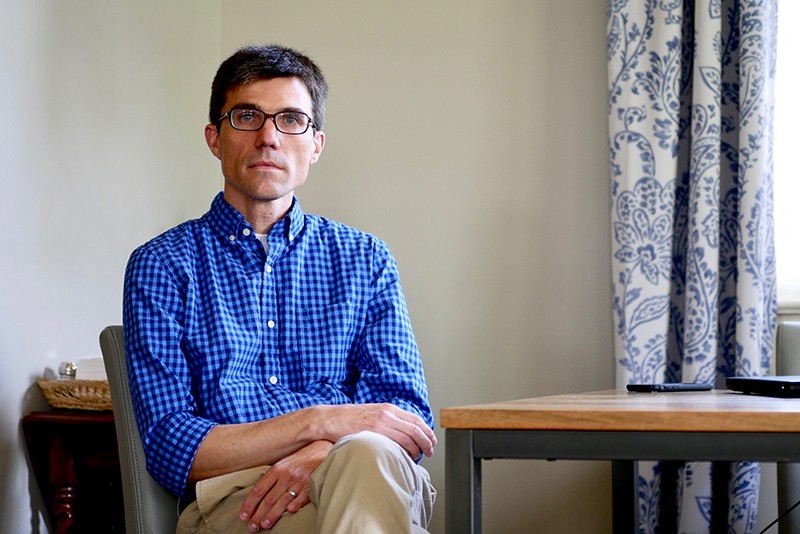VIDEOGRAPHER: ROGER NEWTON
This story is part of a series on public health and firearms. The first examined groups working to reduce homicide in Birmingham. The second interviewed Birmingham Mayor Randall Woodfin about his office’s peace initiative. The third examined a proposed voluntary “do not sell” list for Alabamians suffering mental illness, which aims to prevent firearm access for people with suicidal ideation.
HOMEWOOD, ALA. — Law professor Fredrick Vars, 46, lives on the kind of street you’d see in a movie about the quintessential American Dream: Above neatly manicured lawns, baby swings sway. Kids walk to school along tree-lined sidewalks. Bicycles lean against front porches.
At home on a morning in early August, Vars was dressed as the professor: khakis, a blue button-down, glasses. The house was quiet despite signs of a young family.
Soft-spoken, Vars sipped water from his kids’ Angry Birds cup.
Some may say this isn’t an expected scene for a discussion about suicide. But what is? No place protects people fully from one of this nation’s greatest public health crises. Suicide is the second leading cause of death for young people under 34, and the fourth leading cause of death for people between the ages of 35 to 54, according to the National Institute of Mental Health.
The statistics may be startling in part because local news outlets have a long-standing practice of not reporting suicides. At first a tradition to protect families from what was considered taboo by societal norms, the practice continued to prevent the “copycat” effect. Not reporting suicides may have inadvertently led to deep misunderstanding.
Researching and teaching about the intersection of law and mental illness at the University of Alabama, Vars is working to correct the course. And his work is informed by his own experience.
Today, he considers himself lucky to be alive.
When Vars was 31, a young attorney practicing at a small firm in Chicago, he suffered a life-altering breakdown, was diagnosed with bipolar disorder and began treatment. At his sickest, Vars struggled with suicide ideation so severe, his daily life was in constant disruption.
“I was afraid to go into the kitchen because of the knives,” he said. “I didn’t trust myself.”
Grateful not be one of the 45,000 Americans who die annually of suicide, Vars considers himself lucky because at his darkest time, he didn’t have easy access to a firearm.
Firearms are by far the deadliest means of suicide in the United States, accounting for 50% of self-inflicted fatalities. In Alabama, according to the latest data from the public health department, 70% of suicides are carried out with guns. For every suicide in the U.S., there are 25 attempts, but unlike other common methods of self-harm, self-inflicted gunshot wound survival is rare: Only 15% of people who attempt suicide with a gun survive.
Both here and nationally, the majority of completed suicides are white men. In Alabama, 90% of suicide deaths are white men.

Law professor Frederick Vars is proposing legislation across the country to enable people who suffer mental illness to protect themselves from access to firearms.
In hope of saving lives like his own, Vars is proposing legislation across the country to enable people who suffer mental illness to protect themselves from access to firearms.
Vars likens his measure to so-called “red flag” laws. Supported by top Republican lawmakers, including President Donald Trump, “red flag” laws allow police or family members to petition a court for temporary removal of firearms from persons who present a harm to themselves or others. Vars’ bill is a voluntary, self-imposed restriction.
The bill allows people who suffer mental illness to add their names to a “no sell” list for firearms. Vars is traveling the country with the proposal. So far, the measure has been adopted into law by Washington state, is in consideration in Massachusetts and will be proposed to the Alabama legislature next year.
Republican Rep. Allen Farley, who plans to sponsor the bill in Alabama, said this measure would not “infringe on any American’s Second Amendment Rights.” Instead, he said, it allows people the option to protect themselves in a time of great vulnerability — in a state that ranks poorly for mental health access.
The details of the bill are being worked out: In Alabama, the list would be a temporary, 21-day delay. If adopted in Massachusetts, a mental health provider or judge would decide if the person was well enough to buy a firearm once on the list. To save infrastructure costs, the database would plug into the existing federal background check system.
Working with lawmakers, Vars is hoping to address public fears, which vary state to state: No one — a mental health provider, employer or family member — would be allowed to coerce a person to sign up for the “no sell” list. No one would be allowed to discriminate against a person who does not put their name on the list. In this way, Vars compared the proposed law to existing measures in states with voluntary “no gambling” lists for people who struggle with addiction.
Public and mental health providers across Alabama, including groups dedicated to suicide prevention, support Vars’ efforts. The National Rifle Association does not oppose the bill.
“This isn’t about taking away rights,” Vars said. “This is about creating a better chance for survival.”
He called this measure a “politically achievable” step toward reducing access to firearms for people suffering mental illness. In Alabama alone, he said, the voluntary “no sell” list has the potential to save dozens of lives a year.
“This allows someone to say, ‘You may not know I’m a harm to myself or others, but I do,’” Vars said.
Suicides and white men
A few days after the El Paso and Dayton massacres, while the country was debating whether to focus on mental health care or gun control, Vars said we should be focusing on the intersection of both.
Policy discussions to prevent mass shootings are, of course, important, but there needs to be greater emphasis on who’s at risk for mental health-related firearm deaths, he said.
The startling reality is: The majority of firearm deaths in the U.S. are from suicide.
“[Suicide] doesn’t have that kind of fear factor, which I think really tends to drive the public debate, the public imagination,” Vars said. “People don’t typically imagine themselves the victim of gun suicide” even though suicide ideation, suicide attempts and death by suicide affects people across socioeconomic status, age and gender.
There is one demographic that needs more public health attention: white men.
“Nobody has a good answer.” That’s what David Coombs, president of the Alabama Suicide Prevention and Resources Coalition, said in a recent interview when asked about white men killing themselves at such a high rate.
With the second-highest rate of gun deaths, the latest public health data reports a distinct racial split between those dying by firearm in this state: Of the 1,034 Alabamians who died of gunshots wounds, 82% were men.
Alabama’s suicide victims were 90% white men (72% used a firearm as a weapon), while 60% of gun-related homicide victims in the state are African American men.
Groups working in predominantly black communities to prevent homicide deaths range from government programs to grassroots efforts. But no group in Alabama could be found that is specifically working to save the lives of white men who might commit suicide.
Some studies suggest a link between suicide rates and economic downturns, the societal expectations of men to be the earners of a household, how jobs equal self-worth. Others suggest inherent issues with masculinity and how boys are raised to withhold emotions, to self-medicate rather than seek help when they’re struggling with depression or other forms of mental illness.
But public health research suggests suicide numbers aren’t representative of widespread mental illness among white males so much as they point to issues of firearm access: Though men are 3.5 times more likely to die by suicide than women, adult women reported and are treated for attempts 1.4 times as often than men.
The difference is men are more likely to attempt suicide with guns.
Nearly half of white men own firearms, according to the Pew Research Center.
Coombs said his organization encourages families of suicidal persons to take precautions by removing bullets, adding safety triggers, locking away guns or safely storing guns with family members elsewhere while a person in the house is suffering from suicidal ideation.
Unfortunately, he said, Alabamians have been resistant to those suggestions.
“Many people keep guns because they fear intruders when, in fact, out of all the gun deaths in homes … 90% are either suicides or homicides by people in the house or living in the household. But that doesn’t seem to have much effect,” Coombs said. Intruder-specific firearm deaths aren’t tracked federally, but the FBI data for robbery-related firearm fatalities amounts to a tiny number, under 2% of total homicides in the U.S.
So, how will the proposed law make a difference in the number of firearm-related deaths?
No access to deadly weapons key to survival
When a person is deeply suicidal, suffering enough to make an attempt, it’s often a temporary state of mind brought on by circumstantial crisis or mental illness, particularly depression, according to Coombs.
“Temporary” is the key word.
Nearly 90% of people who survive suicide attempts do not later die by suicide.
Mental illness that triggers suicidal thinking may be lifelong but there’s hope for survival: Like Vars, most people survive suicidal ideation and attempts when they don’t have access to deadly weapons.
Intervention, including tactics like directly asking if someone has a plan to kill himself and disrupting that plan by removing deadly means (weapons, medications, etc.), allows for life-saving delays while a person can seek professional help.
“One of the biggest myths that I encounter very regularly is that suicide is a choice … and that there’s nothing we can do to prevent it,” said Judith Harrington, a counselor and associate professor at the University of Montevallo.
Research shows waiting periods help
Intervention and prevention are made more difficult by easy access to firearms in Alabama, say experts across the fields of public health, mental health and law enforcement.
The idea for the self-imposed “no sell” list came to Vars after researching waiting periods.
“There’s this perception that once you’ve decided to attempt suicide, you’re just going to keep trying until you succeed,” Vars said. “And in fact, the research suggests that’s not true at all.”
Working with Russell Griffin, associate professor in the school of public health at the University of Alabama at Birmingham, Vars conducted a study that looked at waiting periods over three decades, tracking suicide deaths both by firearms and other means. Vars found firearm waiting periods that were as short as 24 hours decreased the overall number of suicide attempts and deaths in a state — not just suicide by firearm.
In other words, people were not using a different means to kill themselves if firearms were less available.
Overall, there was a 2 to 5% reduction in suicide, Vars said, which may not sound like much, but amounts to “hundreds and hundreds and hundreds of lives each year.”
For the voluntary “no sell” or waiting list to work here, Alabamians would have to sign up.
So Vars conducted research at UAB hospital, asking patients receiving mental health care if they would put their names on a “no sell” list to prevent themselves from buying a gun.
Nearly half said yes. Women were slightly more likely to sign up than men, a trend that repeated when Vars conducted a survey with the general population.
Destigmatizing mental health issues, particularly among men, would increase people’s likeliness to sign up, Vars said.
Public health researchers have long documented stories of people who have leaped from the Golden Gate Bridge in attempted suicide, only to realize once their hands left the railing they’d made a huge mistake. The moment they emerged from the water, they felt an overwhelming determination to survive.
People with mental illness may hit that lowest point where they think of attempting suicide, but “they almost always get better,” Vars said. Depression and mental illness never magically disappear, but suicide survivors are happy to be alive.
“Fundamentally, people want to live,” he said.
This story has been updated.
If you or someone you know is suffering from suicidal ideation, call the national suicide hotline at 1-800-273-8255. For help identifying people in your life at risk for suicide, resources (link to sidebar) from the Alabama Suicide Prevention and Resources Coalition.
This story was produced in conjunction with AL.com. It is part of the JJIE’s project on targeting gun violence. Support is provided by The Kendeda Fund. The JJIE is solely responsible for the content and maintains editorial independence.































